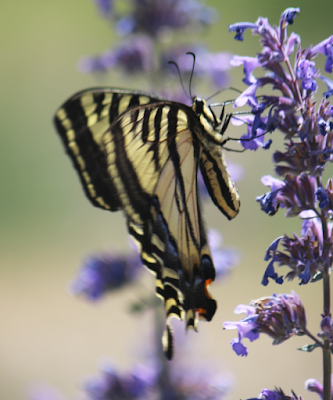The Lesser Goldfinch, also known as the Black-backed or Arkansas Goldfinch, is a small, social, seed-eating songbird. Adult males in breeding plumage are glossy black above, and bright yellow below, with white patches in the wings.
The particular male in the photos below spent a lot of time stripping seeds from the Walker’s Catmint in our Aldea backyard on June 12. This beautiful black and gold bird was an amazing visual contrast with the purple and green of the Catmint. Really made me stop and take notice.
If you are planting varieties of plants that will attract birds, bees, and butterflies, Walker’s Catmint is a good choice to include in your mix. I have also seen House Finches and Pine Siskins eating the dried seeds of Catmint in the winter months. Lesser Goldfinches also love thistle feeders and I have seen them in groups at our thistle feeder in Aldea.
I have occasionally seen Lesser Goldfinches in Aldea in the winter, but mostly in the spring, summer, and fall. They generally move to southern New Mexico and Mexico proper during winter months.
The presence of wild sunflowers, giant ragweed, and bird feeders may attract Lesser Goldfinches to more urban areas. They are also found in jumpers, oaks, and elms, usually near water. These birds often nest semi-colonially with each pair defending only the area near the nest. The lack of territorial singing and other aspects of their behavior make nests difficult to find.
Click on photos to enlarge.









